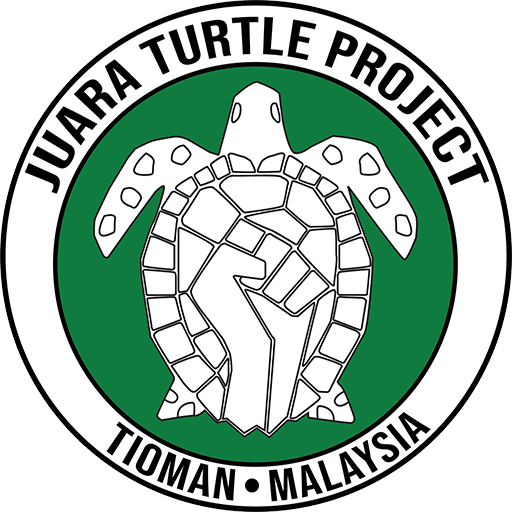Coral Rehabilitation
About Corals
Coral reefs are one of the most biologically important ecosystems. Firstly is because of its biodiversity, as coral reefs are usually compared to tropical rainforests due to similar high biodiversity and low nutrient surroundings. Coral reefs around the world represent only 0.25% of the world’s oceans but they hold around 25% of the total marine biodiversity. Moreover, the quality of local reefs has been a key source of economic growth for local people and businesses. Coral reefs are found across the world's ocean, in both shallow and deep water, but reef-building corals are only found in shallow tropical and subtropical waters, and they represent the substantial part of the reefs. In Peninsular Malaysia, coral reefs are distributed all around the country's coasts.
Coral reefs are formed of thousands of tiny individual animals called polyps. Although some species are solitary, most are colonial. A coral reef is form by multiple species of corals, which taxonomically belong to the class Anthozoa of the phylum Cnidaria – same as jellyfish and sea anemones –. Corals can be classified within the classes Hexacorallia and Octocorallia. Hexacorallia includes the reef-building corals, or stony corals, having polyps with 6 or multiple of 6 feather-like tentacles. Octocorallia includes blue corals and soft corals and they have polyps with an 8 tentacles. Much of the framework of modern coral reefs is formed by reef-building corals.
Hard corals
Reef-building corals, also called hard corals, belong to the group of Scleractinian corals. Stony corals are members of the class Anthozoa and like other members of the group, they don't have a medusa stage in their life cycle. The polyps have a cylindrical body with a mouth on top, surrounded by a ring of tentacles. The founding polyp settles in a hard substrate –usually a rock– and starts secreting calcium carbonate to protect its soft body, making its own exoskeleton. These polyps reproduce asexually by budding, but remain attached to each other, forming a multi-polyp colony of clones with a common skeleton, which can reach up to several metres in diameter or height according to species.
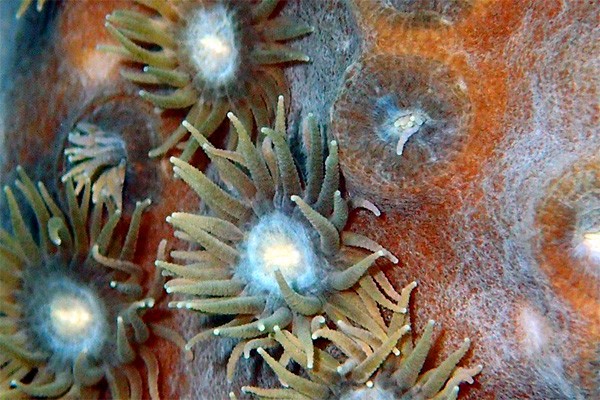
Photo by Alberto Garcia
Soft corals
Soft corals don't have a true stony skeleton as hard corals but they include other skeletal elements made from calcium carbonate called sclerites to toughen their tissues. Soft corals are very variable in form and most are colonial. In both stony and soft corals, the polyps can be retracted, with stony corals relying on their hard skeleton and cnidocytes for defence against predators, and soft corals generally relying on chemical defences in the form of toxic substances present in the tissues called terpenoids.
Unlike hard corals, soft corals normally prefer nutrient-rich waters with less intense light. Almost all species use zooxanthella as a major energy source. However, most will readily eat any free floating food, such as zooplankton, out of the water column. They are integral members of the reef ecosystem and provide habitat for fish, snails, algae and a diversity of other marine species.
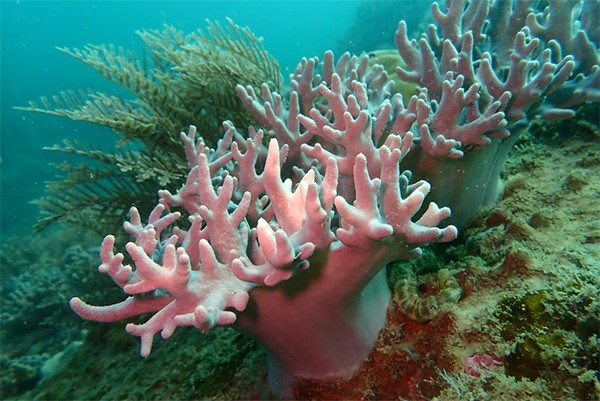
Photo by Alberto Garcia
A symbiotic relationship
The growth pattern and the shape of each coral colony depend not only on the species, but also on its location, depth, and other factors like the amount of water movement. Most of hard corals live symbiotically with a type of unicellular algae known as zooxanthellae within their tissues. The zooxanthellae benefit the corals with the nutrient production. Up to 50% of the organic compounds they produce are used as food by the polyps. This relationship keeps the nutrients recycling within the coral rather than drifting away in ocean currents and can greatly increase the coral's food supply. Via photosynthesis, zooxanthellae provide energy for the coral and aid in calcification. Zooxanthellate hard corals can deposit calcium carbonate up to 10 times faster than non-symbiotic corals. These micro algae also provide their colour to the coral, which thus may vary in hue depending on the symbion species it contains. The coral in return provides protection as well as a nutrient rich environment for algae growth.
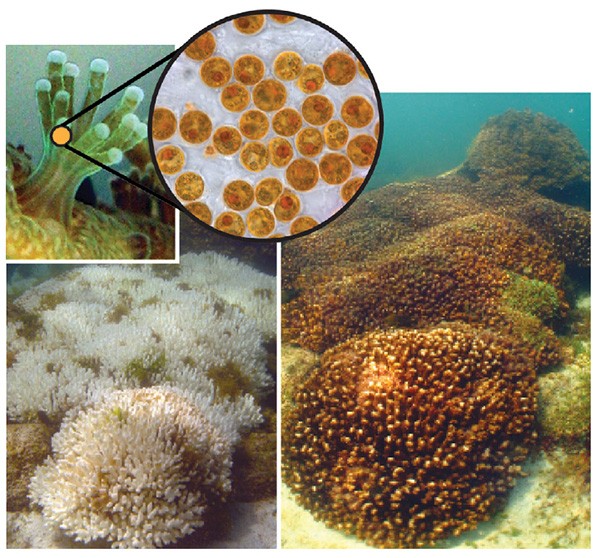
Photo: T.C. LaJeunesse, M. D. Aschaffenburg, D.T. Pettay
Reproduction
Corals can reproduce both sexually and asexually. In sexual reproduction, most species release once or twice a year the gamets into the sea where will take place the fertilisation. As a result, a planula larva is formed and it drifts as part of the plankton until it gets fixed in a hard substrate. Then, it will start developing a new coral colony dividing its cells by mitosis or gemmation.
Asexual reproduction is mostly by fragmentation, when part of a colony becomes detached and reattaches elsewhere. The genetically identical polyps reproduce asexually, either by budding (gemmation) or by dividing by mitosis, whether longitudinally or transversely.
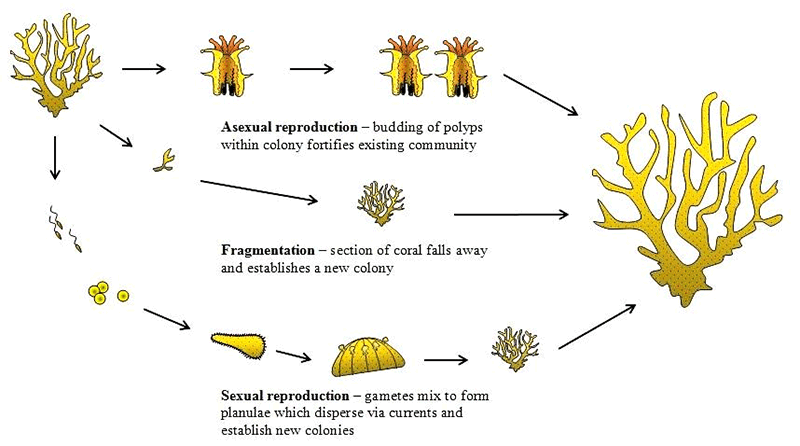
Photo source: The Coral Digest
Threats
From the last few years, coral reefs are among the most threatened ecosystems. Corals are facing multiple stressors at different scales, and all of them are caused by human activities. Every year, more coral reefs are added to a threatened list where, if we don't start now solving the problems, we can have a massive coral reef loss within the next few years. The different threats can be divided by the way they affect, resulting in global or local threats.
Global threats
All threats that effect in a global way, or worldwide, are integrated in this group. We can highlight climate change and ocean acidification.
Climate change
It is well known our world is getting wormer and wormer through the years. Most scientists agree that global climate change is real and a result of human activity. Climate change is a consequence of an increasing global warming. Global warming is the result of the high greenhouse gases concentration in the atmosphere. These gases are mainly carbon dioxide (CO2) and methane (CH4), which have the characteristic of trapping heat. The higher is the CO2 concentration in the atmosphere, the more heat is trapped. In consequence, the temperature of the planet increases. Therefore, and what most of the people don't know, is that more than 70% of the trapped heat is absorbed by the ocean, resulting in an increasing ocean temperature.
Most corals have a very strict temperature tolerance. When ocean temperature increases and the water gets too warm for corals, they become stress. An increase of just 2-3 °C in the ocean temperature is enough to produce what is called coral bleaching. Corals will expel the symbiotic zooxanthellae that are living within their tissues. When corals lose their algae, they not only lose their colour (turning white) but also their main food source.
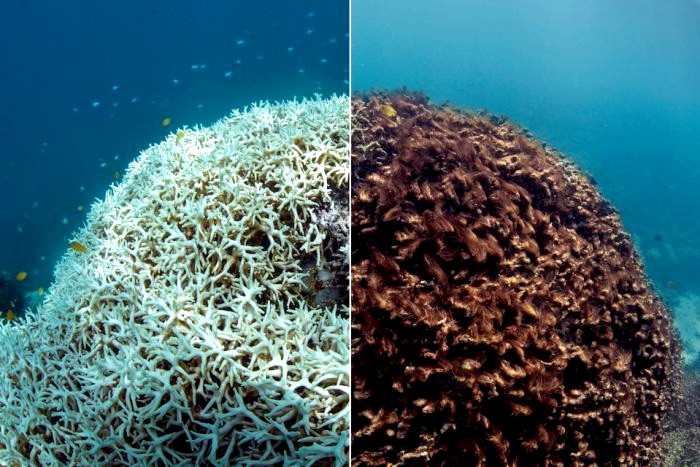
Photo Source: the NOAA
Although corals can survive a bleaching event, they will eventually die if they are under repeated stress or if it is prolonged for a long time. As corals lose their main energy supply, they are no longer able to compete with other macro-organisms, such as macroalgae, which will get fixed on the corals and will finally kill them.
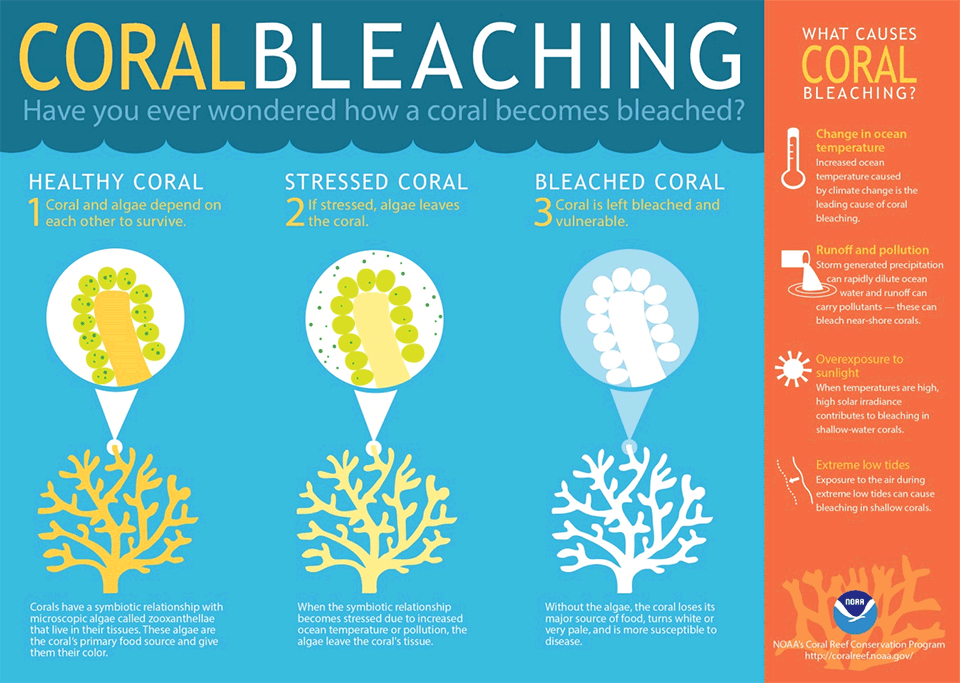
Photo source: The Coral Digest
Therefore, as the ocean temperature gets warmer, ice from glaciers and poles melt, resulting in a rising sea level. Then, corals are predicted to end up in deeper waters, receiving less sunlight and grow more slowly.
Another impact derived from climate change is an increase in the frequency and intensity of tropical storms. Hurricanes, cyclones and typhoons gain their speed and strength from warm ocean temperatures. Then, the warmer is the ocean water, the stronger will be the storms. The consequences may be a more intense damage on coral reefs produced by more powerful waves that can break coral colonies.
Ocean acidification
Since the Industrial Revolution, the concentration of CO2 in the atmosphere has increased by one-third. The more carbon dioxide is released into the atmosphere, the more carbon dioxide is absorbed by sea water. Is estimated that 25% of the total CO2 emitted is absorbed by the ocean. In consequence, the ocean becomes more acidic, making more difficult for corals and other marine organisms to grow their skeletons and shells. The calcification rates of corals and other reef organisms have already begun to decrease. As a result, corals may form weaker skeletons, making them more vulnerable to disease and destruction by storms.
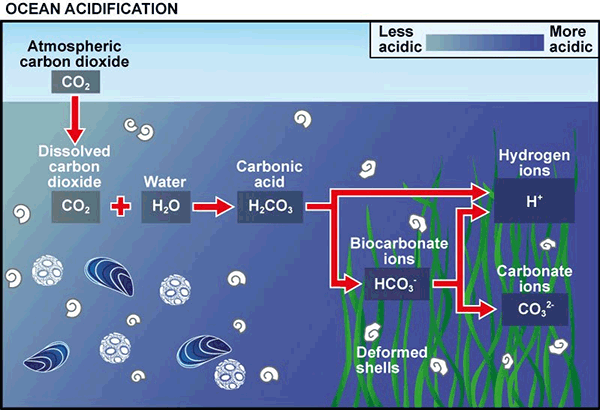
Photo source: The Marine Science Institute Blog
Local threats
This group encompass all those threats which damaged the reef directly on the area where the impact is produced.
Destructive fishing practices and overfishing
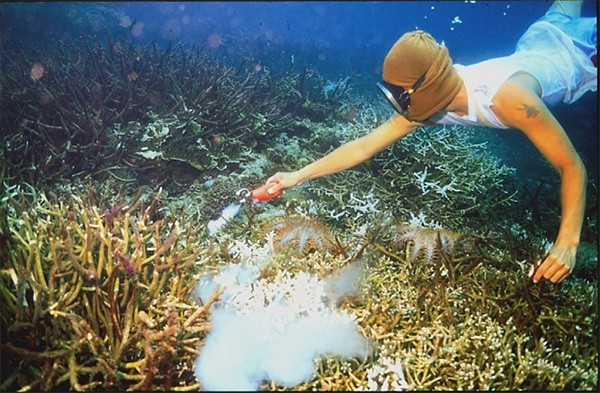
Photo source: Coral Gardening
Fishing with dynamite, cyanide and trawling nets can damage entire reefs and is 100% unsustainable. Both dynamite and cyanide stun the fish, making them easier to catch. Dynamite can destroy an entire reef in just one act. In Peninsular Malaysia, dynamite fishing is not a common practise but in Sabah some fishermen are still using this method. Damaging such vast areas of coral reef habitat on which the fish rely will reduce the productivity of the area, with further impacts on the livelihoods of fishermen.
Fish demand has increase significantly through the years resulting in a fish overexploitation on many coral reefs. Overfishing has a slower negative impact on coral reefs. Overfishing practises affect the food web on a reef. On healthy reefs, algae are kept at low levels thanks to intense predation by herbivorous fish. When these fish disappear, the macroalgae grow limitless as the delicate balance of the reef ecosystem is disrupted.
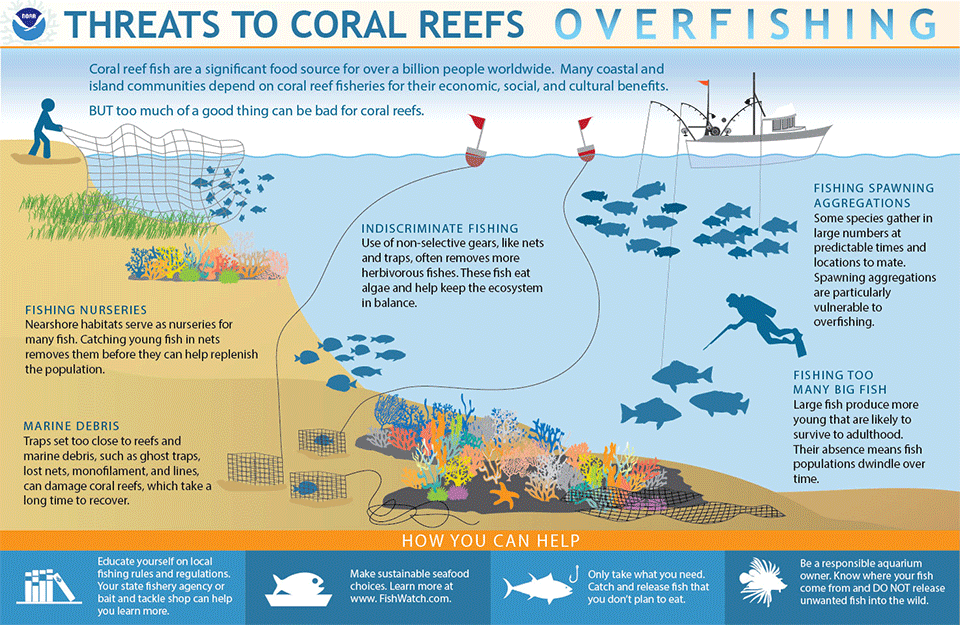
Photo source: Coral Gardening
Pollution
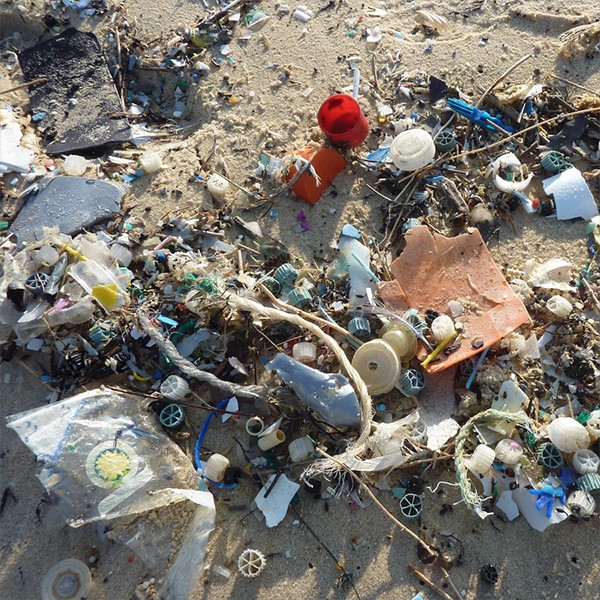
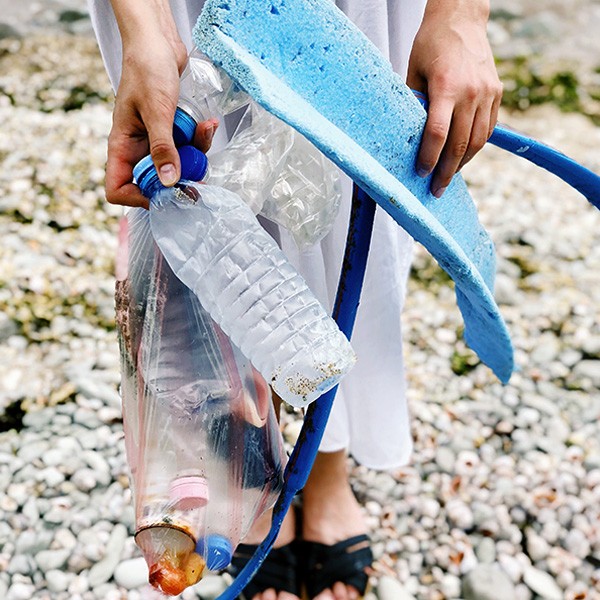
Coral reefs need clean water to survive. Discharged and untreated sewage and wastewater from resorts, restaurants or houses can damage coral reefs when transported by rivers into coastal waters, allowing high levels of nutrients, bacteria, chemicals and pathogens to enter the marine environment. Pollution is damaging reefs worldwide. Corals need waters with a specific nutrient content, and the addition of nutrients causes other species proliferation, such as macroalgae that can killed the corals as it was explained above. The richer is water in nutrients, the bigger is the algae concentration in coastal areas. This high-algae concentration can cause algal blooms, which can block the coral access to sunlight.
Recreational activities
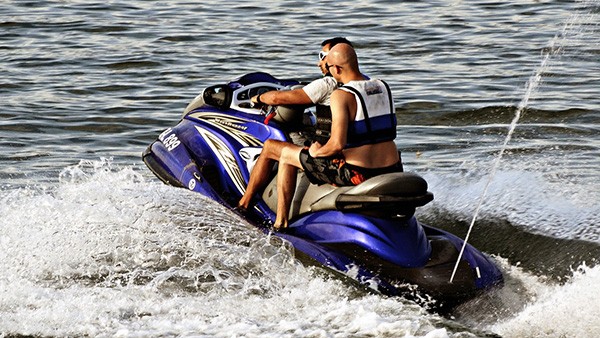
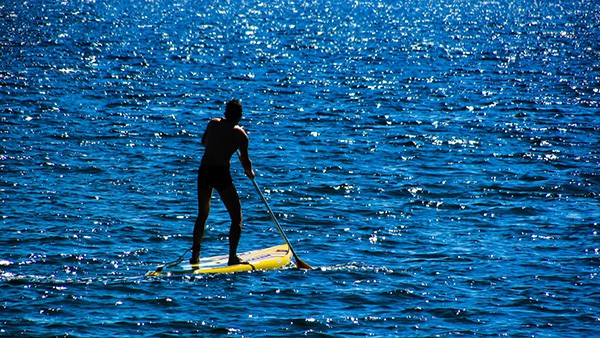
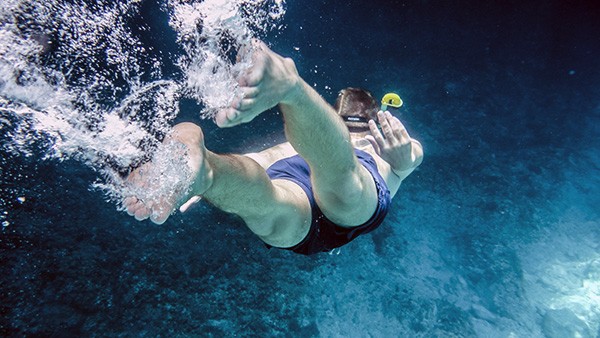
Coral reefs are an important source of income for coastal communities due to the tourist industry. Snorkeling and diving are most profit-providers activities. However, irresponsible tourists activities can damage coral reefs. Snorkelers or divers touching reefs, stirring up sediment or collecting coral can cause additional damages directly on the reef. Tourist companies dropping anchors on reefs also cause a significant damage on the reef. One solution to this problem is to install permanent mooring buoys that can be used by fishing or tourists operators. The creation of Marine Protected Areas (MPA's) is vital to regulate these activities.
Special attention deserves the use of sunscreen. In areas where the presence of tourists is high, coral reefs can be affected by tourist wearing sunscreen, which leaves chemicals in the water that are harmful to reefs. In recent years, researchers have found that several chemicals present on sunscreen affect corals, like for example Oxybenzone. However, there are a few coral-friendly sunscreens which do not damage the reefs.
What We Do
JTP started in 2017 a coral rehabilitation project with the aim to improve the local reefs quality around Juara, but also to provide an educative platform for tourists and local villagers to learn about the threats coral reefs are facing since the past few decade. We recognize the need to maintain coral health, particularly in the vicinity of Juara village.
Local unregulated tourism practices can cause physical damage to the coral through contact from careless swimmers, snorkelers or divers. Corals can also be damaged by higher levels of water pollution which can be caused by increased boat traffic, sewerage run off and excessive use of sunscreen. Juara bay corals have the added threat of the monsoon period - from November to February - which can cause significant damage on the coral cover. In addition to this, coral reefs are under threat globally due to climate change and ocean acidification of the ocean. Therefore, the threat to these fragile ecosystems is urgent and conservation efforts are needed to preserve and restore them before they degrade beyond regeneration.
Coral Reef Rehabilitation In Situ
In Juara Bay there are 3 reefs all with similar substrate characteristics and shape. But there is particularly one reef – called the Middle Reef – which includes several damaged zones formed by rubble. Rubble is just the rest of dead skeletons and broken coral pieces. It is what remains left after a healthy reef has been damaged to death.
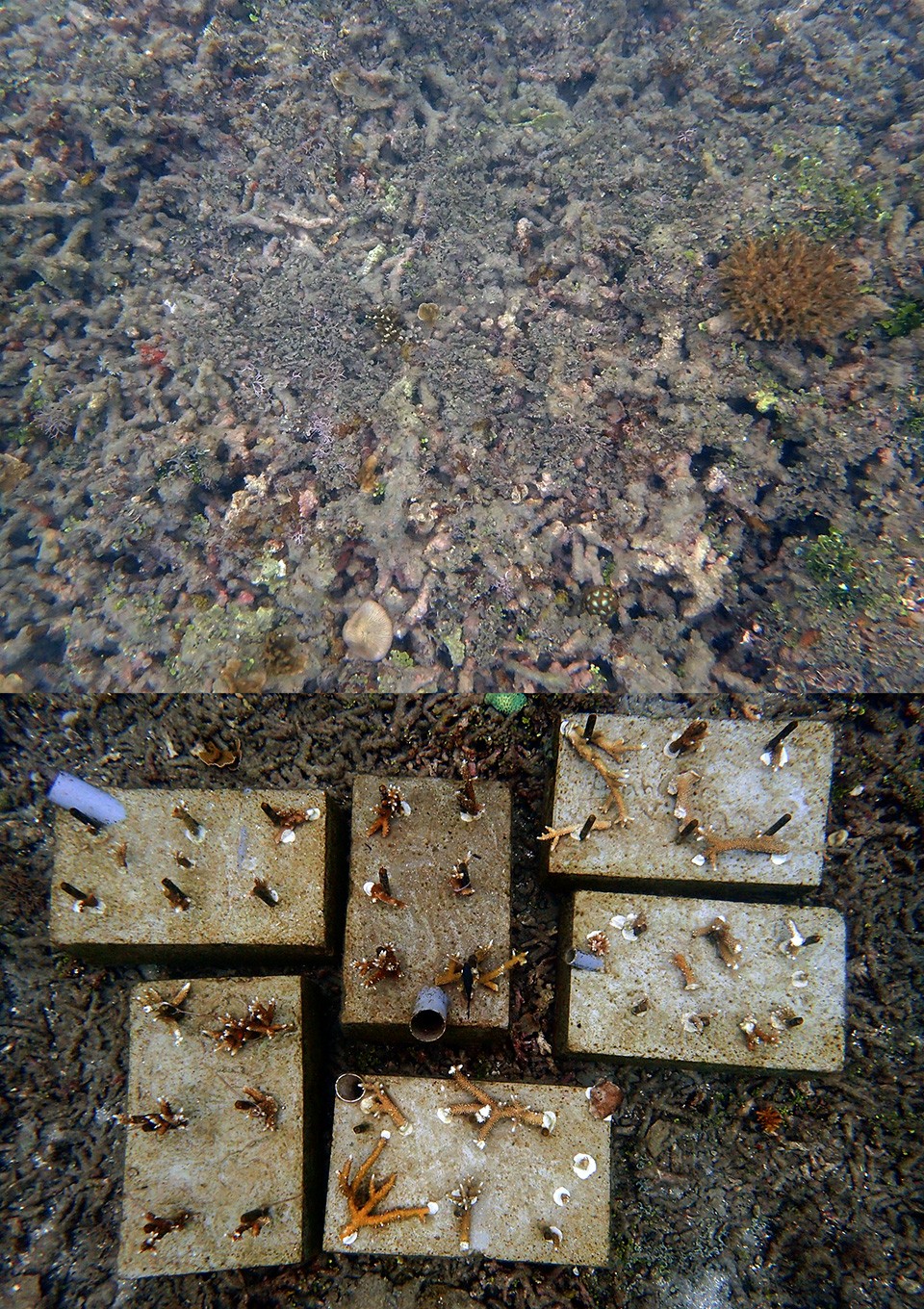
In 2018 JTP developed a new methodology to secure the zones of rubble, consisting in artificial concrete blocks disposed one close to each other. Each block contains few pieces of iron reinforcement bar or glass bottles where small coral pieces are attached to.
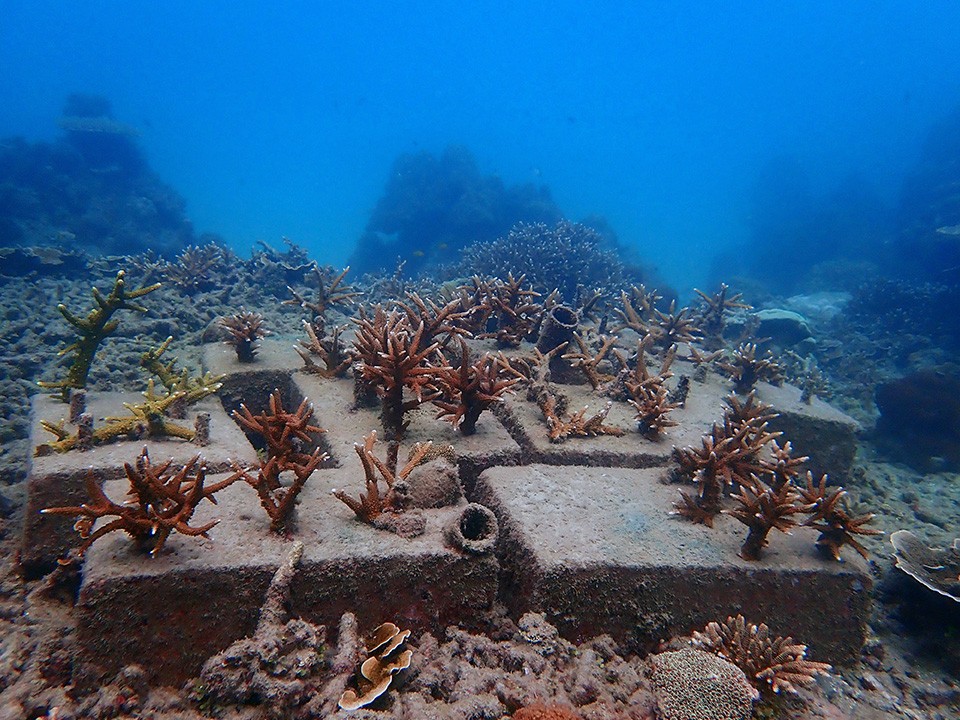
The selected species were mainly branching corals belonged to the genus Acropora because in Tioman it has the highest average cover. To increase coral diversity in the rehabilitation zones, other species are also transplanted.
Doing SCUBA, JTP staff members with the help of volunteers and locals secure the fragments using cable ties or marine epoxy putty and several times per week they are in charge of maintain the structures and collect biodiversity data. Local villagers with proper diving skills are invited to help in the maintenance labours required. It is a good way to encourage local people into marine conservation and, more specifically, into coral reef conservation.
Toothbrushes are used to remove algae and other organisms fixed on the structures. The more organisms are living on the structures, the more the competence for food or for the substrate will increase. Big algae concentration decreases the coral growth and sometimes it can even stop it.
Reef Monitoring
Lineal surveys are conducted on the east coast of Tioman to cooperate with Reef Check Malaysia during their annual reef monitoring around the island - https://www.reefcheck.org.my/ - . The survey consists in a 100 meters transect which is divided in 4 sections of 20 meters each. Each transect is replicated at two different depths, 5 and 10 meters, in order to assess the health status of the reefs.
JTP also assess the reef health status within Juara Bay to monitor possible changes in the reef due to human interferences.
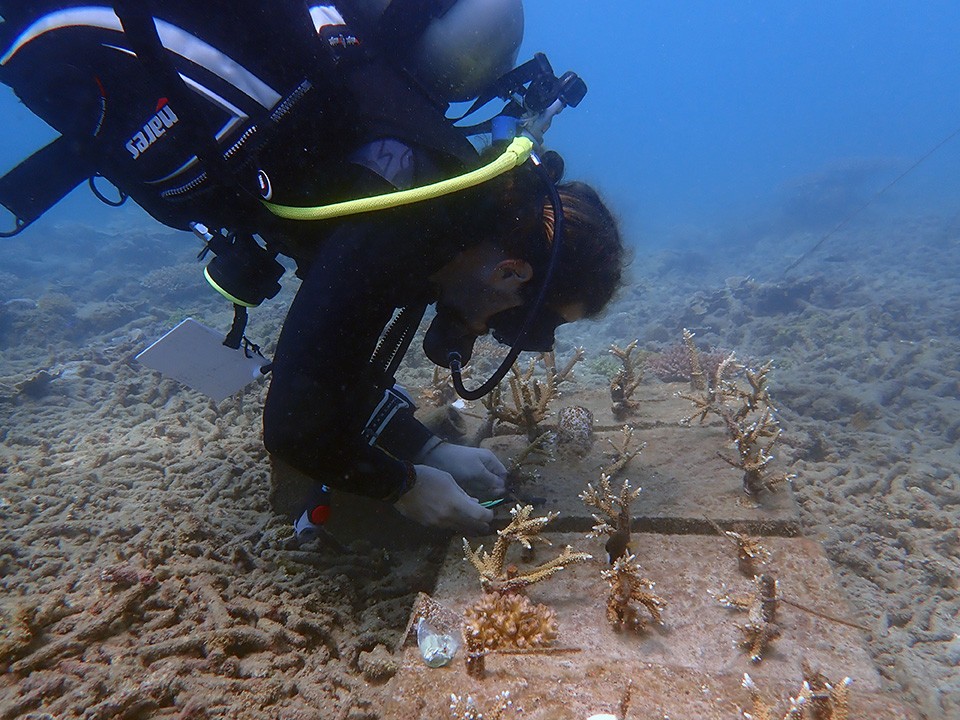
Data of coral cover, fish and invertebrates abundance, anthropogenic impacts and coral diseases are collected. Coral cover measures the hard coral percentage presented on the reef. To calculate the coral cover is necessary to analyse the different types of substrates presented along the survey: hard coral, soft coral, rock, sand, silt, etc. Fish and invertebrates data is collected to analyse presence or absence of key species. These species have either a commercial value or point out a problem in the reef. Fish species such as groupers or snappers have a high food commercial value, whereas excessive numbers of sea urchins point a reef issue.
Reef surveys also allow us to know the healthy status of the reef. The ocean temperature is rising to the highest values ever recorded resulting in coral bleaching. Thus, transects allow us to monitor bleached coral colonies and estimate the percentage of bleached coral colonies. Moreover, with the increased pollution levels in our oceans, corals are more vulnerable to get diseases such as white syndrome, black and brown band diseases, etc.
Ecological Data Compilation
Coral reefs are one of the most biodiverse ecosystems in the world, hosting thousands of different species. JTP studies how different communities are associated to the reefs and in what way.
JTP carries out studies about marine species biodiversity and abundance over the rehabilitation zones. The aim is to compare different ecological parameters such us species richness or diversity between the different rehabilitation zones and damaged and healthy areas.
Each species has a different role in the reef; from territorial species such as damselfishes or groupers to algae-feeders such as cucumbers or wrasses. JTP aims to compare the different fish behaviours in the rehabilitation areas with healthy and damaged zones.
Coral Rehabilitation Ex-Situ: Coral Tank
The coral rehabilitation tank (coral nursery ex situ) is located at the top of the beach, within the Juara Turtle Project's visitor center. The tank is circular with a depth of 1.8 m and 5.5 m diameter, and it has a clear plastic roof to allow sunlight to pass through but prevents contamination by rain and leaves.
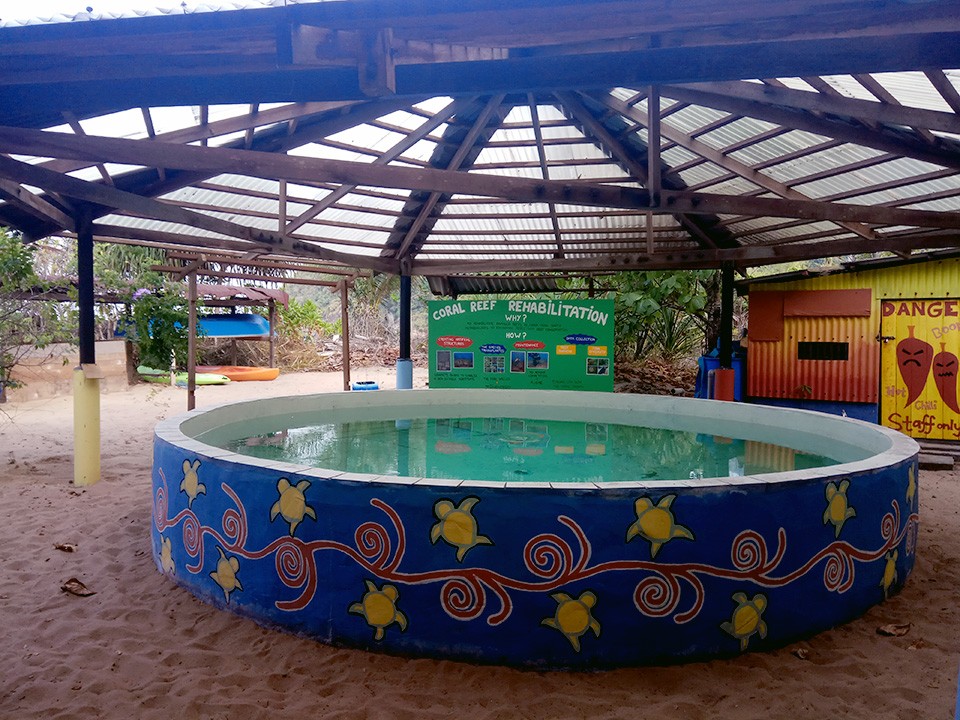
Three PVC structures with a height of 1.5 m and a length of 2 m will be placed inside the tank. Each structure can accommodate 36 fragments, which add up to a total capacity of around 100 fragments. Once the fragments are transplanted, a second batch of corals will be collected and moved to the tank nursery, providing a total capacity of 216 coral fragments per season.
The tank is connected to a PVC tubing-based circulating system. An electrical pump sucks the water from the tank and drives it into a mechanical filter before return it to the tank. The pump allows the water to circulate continuously, creating a constant water flow simulating oceanic currents. The filter retains sand and macroparticles, but microparticles and nutrients are pumped back to the tank to supply with nutrients to the corals. Circulating water prevents algae fixation at the tank surfaces but also slows down water warming.
